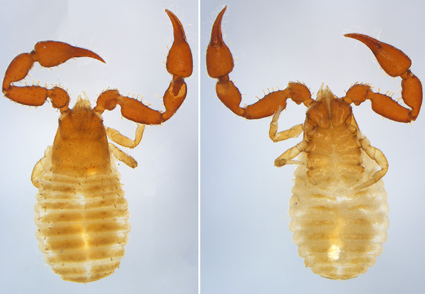Abstract
The pseudoscorpion genus Rhopalochernes Beier, 1932 is restricted to the Neotropical region and currently includes eight species. Recent field collections in the Caribbean region of Colombia have revealed the presence of two previously undescribed species, which are here described as Rhopalochernes luiscarlosi sp. nov. and Rhopalochernes catalinae sp. nov. They differ from one another by the shape of the carapace, the position of the trichobothria and the length of the nodus ramosus. They differ from other species of the genus by the absence of eye spots, and the number of the cheliceral setae. One of these features, the presence of only four setae on the cheliceral hand, is shared with R. panamensis Heurtault, 1998 and R. chamberlini Heurtault, 1998, with other species possessing a higher number. Additionally, the key for the genus proposed by Beier (1932) is updated for included all the species.
References
Beier, M. (1932) Pseudoscorpionidea II: Subord. C. Cheliferinea. Tierreich, 58, i–xxi, 1–294. https://doi.org/10.1515/9783111385402
Beier, M. (1953) Pseudoscorpione aus El Salvador und Guatemala. Senckenbergiana Biologica, 34, 15–28.
Beier, M. (1955) Pseudoscorpionidea. In: E. Titschack (Ed), Beiträge zur Fauna Perus, nach der Ausbeute der Hamburger Südperu-Expedition 1936, und anderen Sammlungen, wie auch auf Grund von Literaturangaben. Gustav Fischer, Jena, Thuringia, pp. 1–12.
Beier, M. (1959) Zur Kenntnis der Pseudoscorpioniden-Fauna des Andengebietes. Beitrage zur Neotropischen Fauna, 1, 185–228. https://doi.org/10.1080/01650525909380614
Beier, M. (1964) Die Pseudoscorpioniden-Fauna Chiles. Annalen des Naturhistorischen Museums in Wien, 1964, 307–375.
Beier, M. (1977) Pseudoscorpionidea. In: Leleup, N. (Ed.), Mission Zoologique Belge aux îles Galapagos et en Ecuador (N. et J. Leleup, 1964–1965). Koninklijk Museum voor Midden-Afrika, Bruxelles, pp. 93–112.
Beier, M. (1978) Pseudoskorpione von den Galapagos-Inseln. Annalen des Naturhistorischen Museums in Wien, 81, 533–547.
Chamberlin, J.C. (1931) The Arachnid order Chelonethida. Stanford University Publications, Biological Sciences, 7 (1), 1–284.
Gao, Z., Zhang, F. & Harvey, M.S. (2017) A modified definition of the genus Haplochernes (Pseudoscorpiones: Chernetidae), with a new species from Hainan Island. The Journal of Arachnology, 45, 112–122. https://doi.org/10.1636/JoA-S-16-042.1
GeoLocator© Development Team (2021) GeoLocator©. Geographic Information system. Open Source Geospatial Foundation Project. Available from: http://tools.freeside.sk/geolocator/geolocator.html (accessed 1 September 2021)
Harvey, M.S. (1992) The phylogeny and classification of the Pseudoscorpionida (Chelicerata: Arachnida). Invertebrate Taxonomy, 6, 1373–1435. https://doi.org/10.1071/IT9921373
Harvey, M.S. & Edward, K.L. (2007) A review of the pseudoscorpion genus Ideoblothrus (Pseudoscorpiones, Syarinidae) from western and northern Australia. Journal of Natural history, 41, 445–472. https://doi.org/10.1080/00222930701219123
Harvey, M.S. & Mahnert, V. (2019) The status of the Central American pseudoscorpion genus Coprochernes Beier, 1976, a new synonym of Neoallochernes Hoff, 1947 (Pseudoscorpiones: Chernetidae). Arachnology, 18, 7–13. https://doi.org/10.13156/arac.2018.18.1.7
Harvey, M.S., Ratnaweera, P.B., Udagama, P. V & Wijesinghe, M.R. (2012) A new species of the pseudoscorpion genus Megachernes (Pseudoscorpiones: Chernetidae) associated with a threatened Sri Lankan rainforest rodent, with a review of host associations of Megachernes. Journal of Natural History, 46, 2519–2535. https://doi.org/10.1080/00222933.2012.707251
Heurtault, J. (1998) Pseudoscorpions of the genus Rhopalochernes (Chernetidae) from Panama and Venezuela. Journal of Arachnology, 26, 442–446.
Judson, M.L.I. (2007) A new and endangered species of the pseudoscorpion genus Lagynochthonius from a cave in Vietnam, with notes on chelal morphology and the composition of the Tyrannochthoniini (Arachnida, Chelonethi, Chthoniidae). Zootaxa 1627 (1), 53–68. https://doi.org/10.11646/zootaxa.1627.1.4
Mahnert, V. (2016) Re-description of eight species described by Luigi Balzan from South America (Argentina, Brazil, Paraguay)(Pseudoscorpiones: Chernetidae). Opuscula Zoologica, Budapest, 47, 73–85. https://doi.org/10.18348/opzool.2016.1.73
Morrone, J.J. (2014) Biogeographical regionalisation of the Neotropical region. Zootaxa, 3782 (1), 1–110. https://doi.org/10.11646/zootaxa.3782.1.1
QGIS Development Team (2021) QGIS Geographic Information System. Available from: https://qgis.org (accessed 23 May 2022)
Villarreal, E., Martínez, N. & Ortiz, C.R. (2019) Diversity of Pseudoscorpiones (Arthropoda: Arachnida) in two fragments of dry tropical forest in the colombian Caribbean region. Caldasia, 41, 139–151. https://doi.org/10.15446/caldasia.v41n1.72189
World Pseudoscorpiones Catalog (2021) World Pseudoscorpiones Catalog. Natural History Museum Bern, Bern. Available from: http://wac.nmbe.ch (accessed 5 November 2021)


